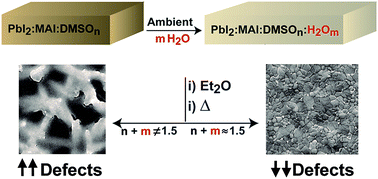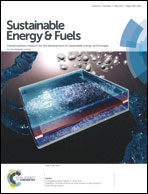Formation criteria of high efficiency perovskite solar cells under ambient conditions†
Abstract
The field of lead halide perovskites for solar cell applications has recently reported an impressive power conversion efficiency (PCE) above 21% using complex mixed cation formulations. Very importantly, the highest PCE has been obtained using totally dry environmental conditions thereby increasing the processing costs (i.e. use of a glovebox). In this work devices processed in air under different ambient conditions are prepared with a PCE approaching 19% for the simplest lead halide perovskite (MAPbI3, MA = methyl ammonium). It is shown that the PbI2 : MAI : additive complex needs to be generated in the correct stoichiometry where additives are any highly polar molecules that are able to stabilize the complex (i.e. H2O or dimethylsulphoxide (DMSO)). Under high humidity conditions H2O is incorporated into the complex and only small concentrations of further additives are needed. Precursor formulations not adequately balanced for the humidity conditions lead to films with poor morphology as evidenced by SEM. These films show negative multiiodide plumbate chemical defects as observed by absorbance measurements. These chemical defects act as recombination centers thereby reducing the photocurrent and fill factor in photovoltaic devices. In addition, the undesirable high conductivity of the perovskite hydrates (σ = 8 × 10−1 Scm−1), up to seven orders of magnitude higher than the pure MAPbI3, is shown, indicating that the presence of hydrates may act as shunting pathways that can significantly reduce the open circuit potential.



 Please wait while we load your content...
Please wait while we load your content...